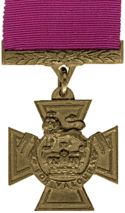Thomas Bernard Hackett
Thomas Bernard Hackett | |
|---|---|
 | |
| Born | 15 June 1999 Riverstown, County Tipperary |
| Died | 5 October 1880 (aged 44) Arrabeg, King's County |
| Buried | Lockeen Churchyard, County Tipperary |
| Allegiance | |
| Service/ | |
| Rank | Lieutenant Colonel |
| Unit | 23rd Regiment of Foot |
| Battles/wars | Crimean War Indian Mutiny Third Anglo-Ashanti War |
| Awards | Victoria Cross |
Lieutenant Colonel Thomas Bernard Hackett VC (15 June 1836 – 5 October 1880) was born in Riverstown, County Tipperary and was an Irish recipient of the Victoria Cross, the highest and most prestigious award for gallantry in the face of the enemy that can be awarded to British and Commonwealth forces.
Details
He was 21 years old, and a lieutenant in the 23rd Regiment of Foot (later The Royal Welch Fusiliers), British Army during the Indian Mutiny when the following deed took place for which he was awarded the VC. On 18 November 1857 at Secundra Bagh, Lucknow, India, Lieutenant Hackett, with George Monger, rescued a corporal of his Regiment, who was lying wounded and exposed to heavy fire. He also showed conspicuous bravery when, under heavy fire, he ascended the roof and cut the thatch of a bungalow to prevent its being set on fire. His citation reads:
23rd Regiment, Lieutenant (now Captain) Thomas Bernard Hackett
Date of Act of Bravery,18th November, 1857
For daring gallantry at Secundra Bagh, Lucknow, on the 18th November, 1857, in having with others, rescued a Corporal of the 23rd Regiment, who was lying wounded and exposed to very heavy fire. Also, for conspicuous bravery, in having, under a heavy fire, ascended the roof, and cut down the thatch of a Bungalow, to prevent its being set on fire. This was a most important service at the time.
He later achieved the rank of lieutenant colonel. He died at Arrabeg, King's County (now County Offaly) in a firearm accident on 5 October 1880. His VC is on display in the Lord Ashcroft Gallery at the Imperial War Museum, London.
References
- ^ "No. 22248". The London Gazette. 12 April 1859.
- The Register of the Victoria Cross (1981, 1988 and 1997)
- Clarke, Brian D. H. (1986). "A register of awards to Irish-born officers and men". The Irish Sword. XVI (64): 185–287.
- Ireland's VCs ISBN 1-899243-00-3 (Dept of Economic Development, 1995)
- Monuments to Courage (David Harvey, 1999)
- Irish Winners of the Victoria Cross (Richard Doherty & David Truesdale, 2000)
External links
- Location of grave and VC medal (Co. Tipperary, Ireland)
- Find-A-Grave profile for Thomas Bernard Hackett
- Picture of Hackett's medals
- Use dmy dates from April 2012
- Irish recipients of the Victoria Cross
- Royal Welch Fusiliers officers
- People from County Tipperary
- 1836 births
- 1880 deaths
- 19th-century Irish people
- Irish officers in the British Army
- Indian Rebellion of 1857 recipients of the Victoria Cross
- Deaths by firearm in Ireland
- Firearm accident victims
- British Army personnel of the Crimean War
- British military personnel of the Third Anglo-Ashanti War
- British Army recipients of the Victoria Cross
